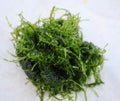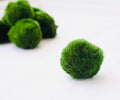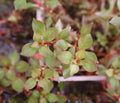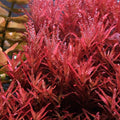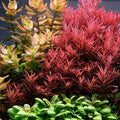Why Do Aquarium Plants Melt? (Part 2)
Why Aquarium Plants Melt Down
Here are some reasons why aquarium plants melt down.
Ammonia Burn
Ammonia Burn In unclean tanks with bad water and little to no maintenance, ammonia burn is a typical issue.
Because ammonia is a toxic gas that may harm all aquatic life, including plants and animals. This substance is produced when dead material in the tank decomposes and is eaten by bacteria, which then release ammonia and nitrites.
Nitrifying bacteria often get rid of these chemicals by turning them into nitrates, which are much less dangerous.
The issue arises when the tank has not cycled (does not include nitrifying bacteria), which will lead to a rapid increase in ammonia levels.
When the amount of trash is more than what the biofilm can handle, the same thing is likely to happen.
This occurs in crowded tanks with poor maintenance and infrequent water changes.
Fish and plants both often exhibit the same ammonia burns. When a plant withers and dies, its leaves exhibit rusty hues and gradually become paler.
The severity of the ammonia buildup will determine how quickly these problems develop.
Consider the following to reduce or, better yet, avoid ammonia buildup:
- Make sure the biofilm is flourishing and the aquarium has been cycled appropriately.
- Remove food and fish waste to reduce the amount of work the biofilm will have to do. Change the water often, ideally once a week, to keep it clean and reoxygenated.
- Avoid overfishing; the greater the number of fish in a given area, the greater the bioload and the environmental effect.
- Don't use chemicals to clean the filtering system or other parts of the tank because they could make the water dirty and hurt the biofilm.
- Methane pockets often form in sandy soils. To avoid them, move the sand around every so often.
- Always keep an eye on the water's properties to spot any ammonia poisoning symptoms early.
- In essence, ammonia levels must always be zero. Any quantity, no matter how little, will have an obvious effect on the surrounding ecosystem and aquatic life.
Plant Illness
Tank plants may really get a number of illnesses that might quickly destroy them.The good news is that poor water quality is probably the cause of all these plant illnesses. Plant fungus, which looks like white fuzz on the leaves, can cause this kind of problem.
Due to their symptoms, nutrient deficiencies might be regarded as illnesses.
Other plant diseases, like Anubias rot, are more specific. Plants whose rhizomes have been buried too deeply in the substrate often suffer from this problem.
If left untreated, the rhizome may start to decay, possibly destroying the plant. A diseased plant may exhibit symptoms such as color changes and wilting leaves.
Always be aware of the disorder's warning signals since they are gradual, but sometimes extremely fast.
Unclean Waters
This one really is as easy as it seems. In unclean tank waters, the majority of aquatic plants won't thrive.
The more floating waste and debris in the water, the more of it the plant needs to cope with.
Unhygienic fluids will eventually upset the plant's comfort and put it under a lot of stress.
The plant won't be able to absorb nutrients if the water is contaminated with particles. To avoid this, maintain the quality of your water at all times.
Not to mention that fish will be harmed by polluted waterways.
To solve or even avoid the problem, you need a good filtration system, regular tank maintenance, and maybe once a week water changes.
Remember to only make 10-15% water changes since anything more will disturb the biofilm in the tank.
Algae Growth
In dirty tanks with bad water quality, algae growth is always a problem.
Numerous factors, including unfavorable water conditions, excessive illumination, insufficient CO2 in the water, etc., may encourage the development of algae.
Even though algae might not be dangerous right away, ignoring the problem will eventually hurt the plant.
Typically, the algae will spread everywhere, even on the plants. The growing algal mass will block the plant's access to light, thereby starving it.
Due to the fact that plants and algae eat essentially the same things, nutrient competition will also create problems.
You must control the algae population in order to avoid that.
If the algae get out of hand, add some algae eaters, maintain a reasonable lighting level, and even clip the algae by hand.
Algae spreads and grows faster in dirty water, so it's important to stick to a regular maintenance schedule.
How Can Aquarium Plants Be Prevented from Melting?
As you can see, the melting problem has multiple causes rather than just one.It seems logical that the answer would take a variety of forms.
Maintain the tank water's cleanliness, oxygenation, and absence of floating objects (as much as possible).
- To stop algae development, raise the CO2 level in the tank.
- Improve lighting management (too much will promote algae, too little is not enough for photosynthesis to occur).
- To avoid any vitamin deficits, make sure the water has adequate nutrients.
- Watch out for rhizome rot and plant fungal symptoms.
- Maintain a healthy maintenance schedule that includes frequent water changes to prevent ammonia accumulation.
- The good news is that plant melting happens gradually, giving you enough time to respond to what you're experiencing.
And because the idea of "melting" essentially depicts the process of dying, you had best watch it.
Can You Save Aquarium Plants That Are Melting?
It varies. Melting plants may sometimes be saved, but occasionally they are beyond rescue.
It all depends on the cause of the melting and how serious the problem is. The good news is that most aquarium plants are very hardy and have an amazing ability to adapt and grow back.
If you see that your plant is melting, analyze the situation to see what's going on.
You'll be better able to identify the correct steps required to solve the issue if you do this.
Conclusion: Fish and plants both need care.
More significantly, the water in the tank is more stable and well-oxygenated with healthier plants, which benefits the fish.
You should give plants the attention they need to flourish since they are an important component of the environment.



